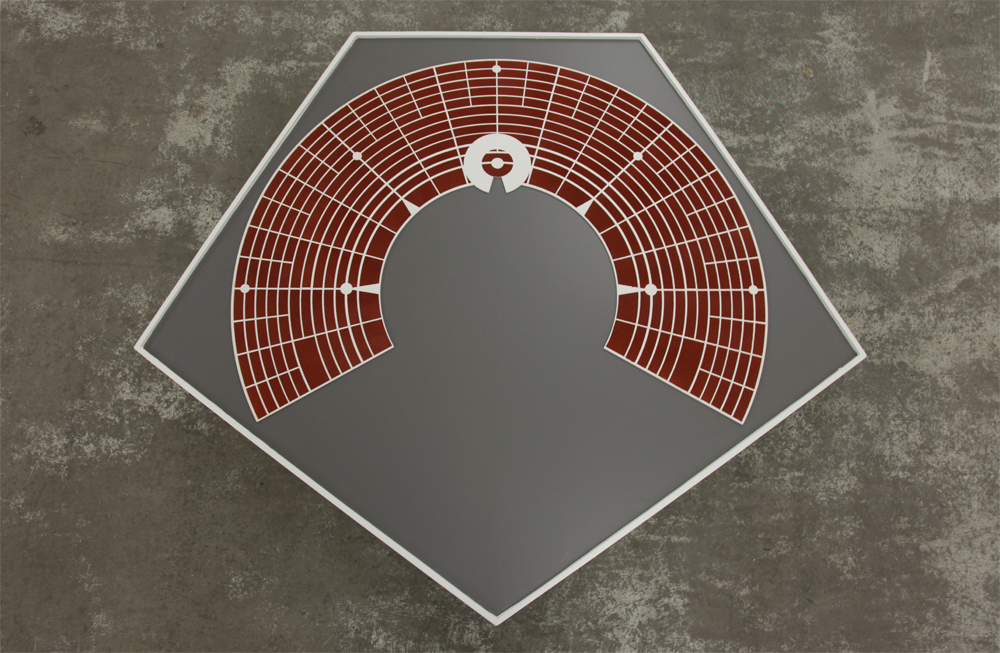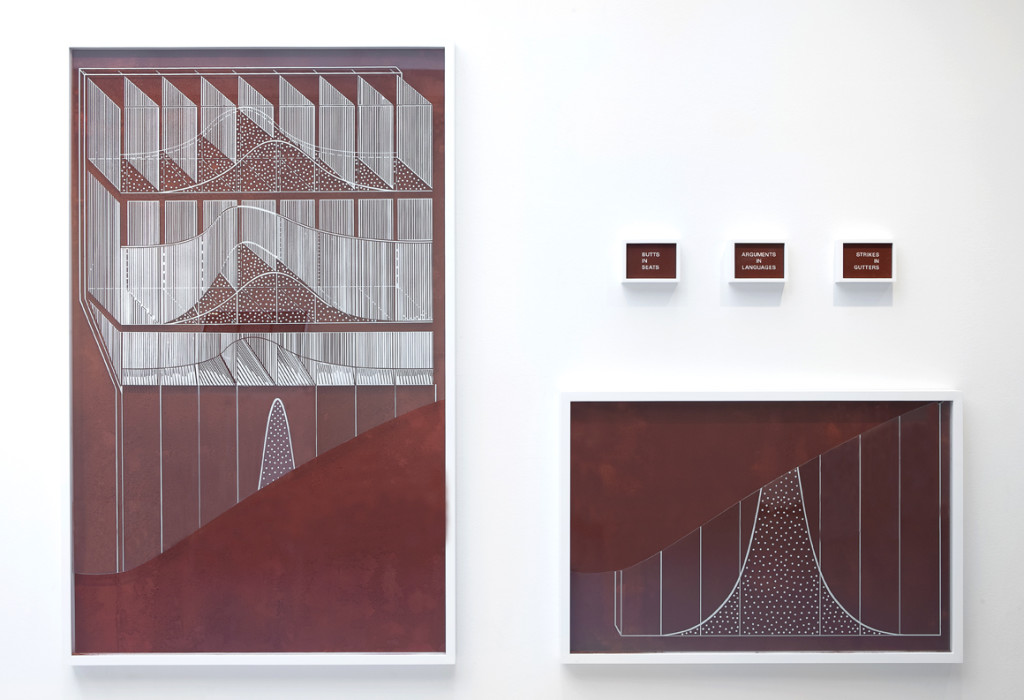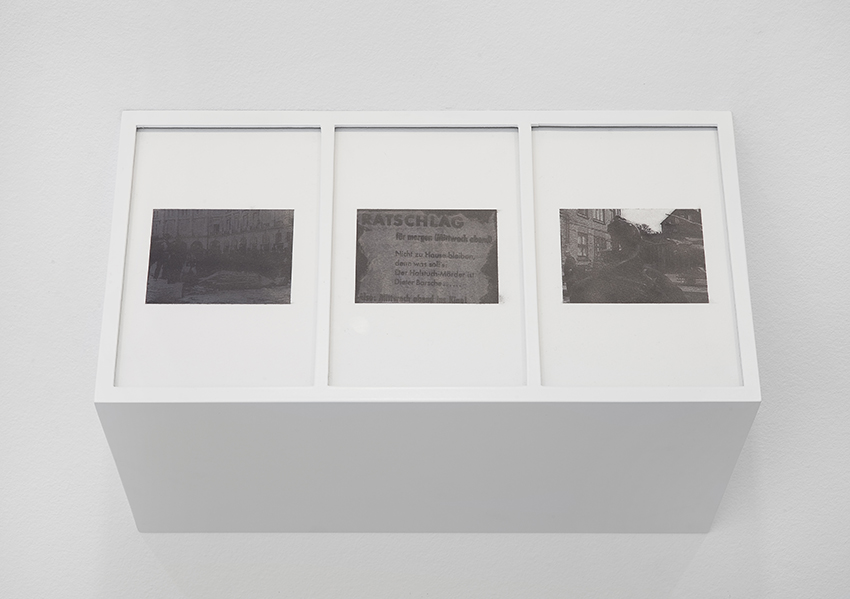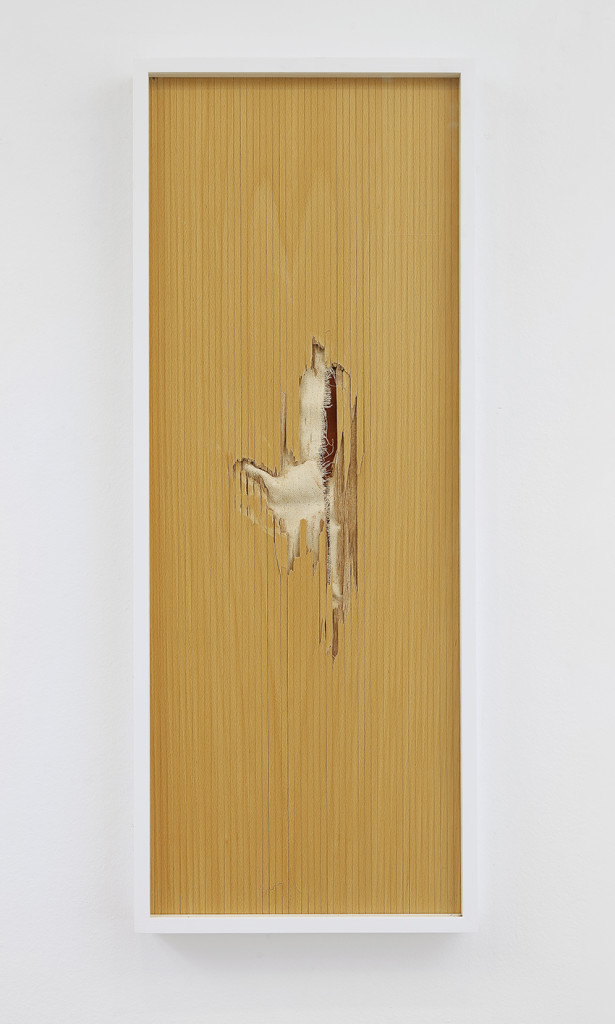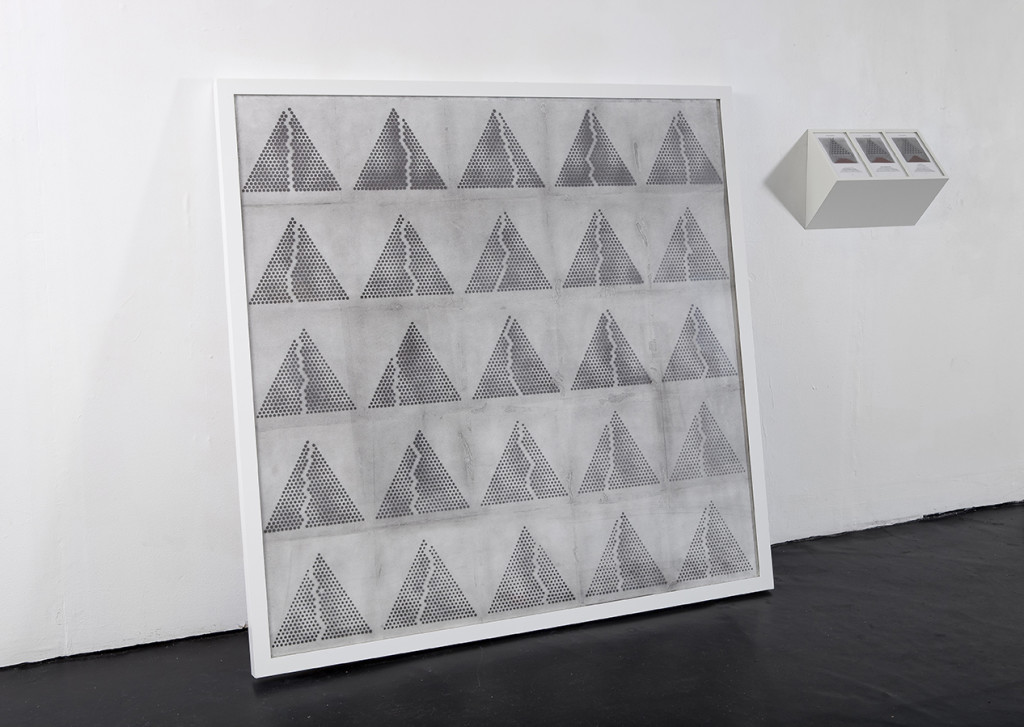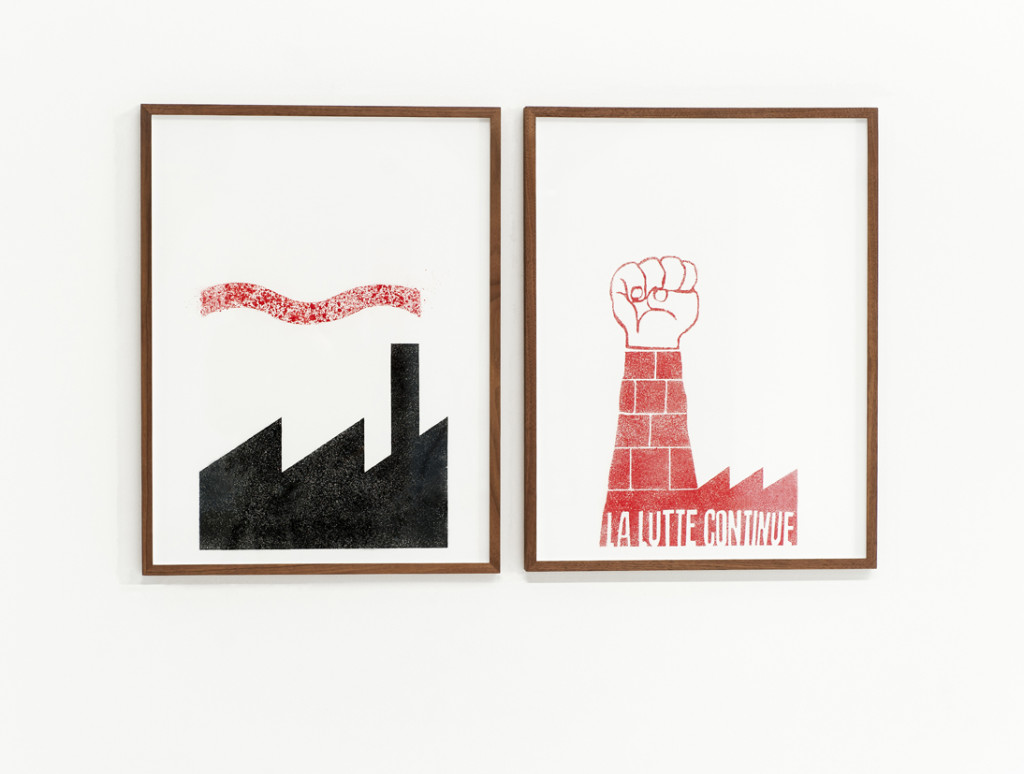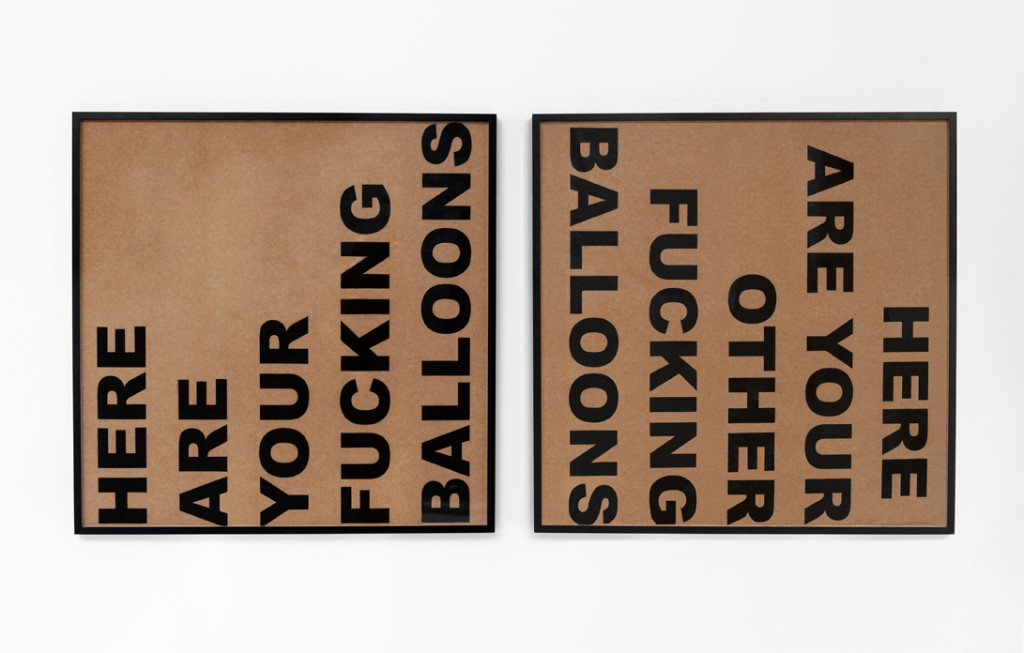Drawings
…
(Model for) Barely Historical Site
Sanguine powder on spray painted, lazer cut MDF
Mounted on pentagonal display table in spray painted MDF
140 x 160 cm, Table height: 75 cm
Display table built with the kind assistance of Adam Grinovich
2014
The geometrical C-shaped pattern made with sanguine powder (a red chalk which gets its colour from the mineral Hermatite) is based on an aerial photograph of Black Rock City, a temporary settlement which is built and removed annually in the Black Rock Desert in Northern Nevada by the participants of the Burning Man Event. This festival or event is a week-long gathering wherein ”attendees dedicate themselves to the spirit of community, art, self-expression, and self-reliance” and temporarily establish the infrastructure of a utopian society unmediated by commercial sponsorships, financial transactions and advertising. The participants are encouraged to rely solely on a gift economy in place of monetary systems and no physical trace of the event is left when the festival is over.
Please click the thumbnails below the dotted line for more images and plan drawings.
……………….
……………………………………………………………………………………………………………………………………………………………………………………………………………
[nggallery id=36]
..
……
An Illustrated and Radically Condensed Timeline of French History from March 22nd to May 13th, 1968
Laquer on glass / sanguine powder on MDF / sanguine powder on paper
100 x 167 cm / 100 x 63 cm / three drawings in size 9,75 x 13,5 cm
2014
Photo: Øystein Thorvaldsen
Installation view from the exhibition Some General Thoughts on Wreckage, Tegnerforbundet, Oslo, 2014.
….
Please click the thumbnails below the dotted line for more images.
……………….
……………………………………………………………………………………………………………………………………………………………………………………………………………
….
[nggallery id=41]
….
….
April 16th, 1871 to April 25th, 1964: The Century in Push, Shove and Sabotage
Inkjet print and powdered graphite on archival matte paper
Each image 7,1 x 9,7 cm (unframed)
Mounted in display unit in spray painted MDF
2014
Photo: Øystein Thorvaldsen
The image to the left is a photo of members of the Paris Commune standing behind the toppled Vendôme Column, a monument honoring the war efforts of Napoleon which was destroyed by the communards on April 16th, 1871. The Paris Commune was a revolutionary government that briefly ruled Paris from 18 March until 28 May 1871 and was established by workers who set about re-organising society in their own interests based on workers’ councils. The insurrection of the Paris Commune is often referred to as the first socialist working class uprising in history.
The middle image is a facsimile of a classified advertisement placed in the German newspaper Der Abend in 1962 which revealed the identity of the killer in a television detective series that had been keeping the nation in suspense for weeks. This highly inventive act of mediative sabotage (courtesy the of German actor Wolfgang Neuss) was celebrated in the seventh issue of the SI magazine Internationale Situationniste in the same year, to illustrate how ” it isn’t only industrial workers who are fighting against brutalization”.
The image to the right is a photo of the Danish sculptor Edvard Eriksens famous statue The Little Mermaid, taken after it was decapitated for the first time in 1964. Jørgen Nash – one of the leading figures in the Second Situationist International and brother of SI founding member Asger Jorn – admitted in his autobiography some thirty-odd years later that he knew the perpetrators and that he had personally disposed of the mermaid’s head in a nearby swamp in Copenhagen.
Please click the thumbnails below the dotted line for more images.
……………….
……………………………………………………………………………………………………………………………………………………………………………………………………………
[nggallery id=40]
…
…
….
Puncture
Penetrated cabinet door and sanguine powder on MDF
30 x 75 cm
2014
Photo: Øystein Thorvaldsen
…
…
………
Alternate Routes
Powdered graphite, acetone transfer and pencil on paper
Large image: 140 x 140 cm (unframed)
Small images 12,7 x 19,8 cm (each, unframed)
Display unit built with the kind assistance of Hangmen AB, Stockholm
2013
Installation view from the exhibition Idiot Cards For a Bygone Revolt, NoPlace, Oslo, 2013.
Photo: Øystein Thorvaldsen
This work uses the mathematical device known as the Galton Board (more popularly called a bean machine) as a starting point. The Galton Board is an analogue instrument invented by Sir Frances Galton in the 19th century to demonstrate normal distribution of random variables introduced into a controlled system. In a vertical hermetic container, horizontal pins divide the available space into diagonal pockets and paths. Below the pins is a catchment area, divided into columns each equal in width. Several balls are funneled into the top of the board, and gravity and a series of collisions with the pins draw them downwards along different paths. Galton observed that despite the random nature of the balls’ journeys, most of them landed in the central columns, producing an overall distribution resembling a bell-shaped curve. Galton’s device was later applied to illustrate “the artistic problems of the dérive” in Asger Jorn’s 1958 text The Situationists and Automation and the bell-shaped curve which appears in the container at the bottom when a sufficient number of balls have made their way accross the board is a recurrent literary metaphor in the writings of Thomas Pynchon. The three small text drawings in the diplay unit to the left contain references to Jorn’s text on automation as well as a composite of quotations from Pynchon’s short fiction and novels.
……
Please click the thumbnails below the dotted line for detailed images of individual drawings.
……………….
…………………………………………………………………………………………………………………………………………………………………………………………………………….
………………………………
[nggallery id=30]
…….
….
…
Comparative Analysis (Fac 120 ≠ La Lutte Continue)
Powdered charcoal and raw pigment on paper
Each drawing 60 x 40 cm (unframed)
2013
Photo: Johanna Wulff
This work addresses the popcultural recycling (recuperation, possibly) of the aesthetics of post-war continental radicalism in the design program of legendary 1980s record label Factory Records (founded by SI-sympathiser Tony Wilson). The drawing to the left is a rendition of the Factory Records logo (designed by Peter Saville Associates in 1984) and the drawing to the right is based on a French socialist poster which was heavily distributed by the Atelier Populaire during the May 1968 events in Paris.
…
…
…
…
….
Potlatch (Running Joke Running Dry)
Powdered charcoal on MDF
Each panel 100 x 100 cm (unframed)
2013
Photo: Johanna Wulff
This work references a vaguely amusing in-joke featured in a video by novelist/writer/musician/self-proclaimed grump Joe Pernice and recontextualizes Pernice’s imaginary balloon delivery service (described in the video, as well as in this book) as a crude visualization of the primary economic system known as Potlatch (moreover the name of the magazine published by the Lettrist International from 1954 to 1957). The typographical displacement of the word HERE in the right panel is intended to recall the competitive element in the Potlatch economy, shortly put the point of asserting dominance by giving away an object of greater value than the one(s) received.
…….
…..
Storyboard (Hurlements en faveur de Sade)
Powdered charcoal on paper, frames, wooden table, cotton gloves
Each drawing 21 x 29,7 cm
2011
Installation view from the exhibition Idiot Cards For a Bygone Revolt, NoPlace, Oslo, 2013.
Photo: Øystein Thorvaldsen
This series is a sequence of drawings based on the script of Guy Debord’s cinematic debut Hurlements en faveur de Sade (1952). The work consists of a grid with twenty-eight drawings in which texts from the script’s marginalia alternate with compositions based on the famously blank screen from Debord’s film.
Click here to see Debord’s film in full (via UbuWeb)
Click here to read Ken Knabb’s translation of Debord’s script (via Bureau of Public Secrets)
Please click the thumbnails below the dotted line for detailed images of individual drawings.
……
…………………………………………………………………………………………………………………………………………………………………………………………………………….….
….
…
[nggallery id=24]…
………
…….
An Incomplete Account of Past Sensations
………….
Acetone transfer and pencil on paper
Text drawings and blank paper sheets mounted in 244 wooden frames
205 x 484 cm, each drawing 18 x 18 cm (unframed)
2012
Installation view from the exhibition Game of Life, Kristiansand Kunsthall, Kristiansand, Norway, 2012
Photo: Studio LL
This work is based on Wikipedia’s incomplete list of riots in the 20th century. The composition consists of 244 individual ready-made frames mounted in a grid corresponding to a simplified map projection. Texts with names of cities and calendar years (referring to events listed in the Wiki-entry) are placed according to their geographical position. In short, the work is a delimited political map highlighting the Euro-and Americentrism of Wikipedia’s “encyclopedic” account of 20th century riots.
……………..
Please click the thumbnails below the dotted line for more images.
……………….
…………………………………………………………………………………………………………………………………………………………………………………………………………….
………………………………
[nggallery id=25]
….
…
[nggallery id=16]
Opening Chord
Clash City Rockers (Strummer/Jones)
CBS Records,1978
Geometric representation of E minor chord generated with ChordGeometries version 1.1
Software developed by Dmitri Tymoczko, © 2006.
Digital print and coloured pencil on millimeter paper
23 x 23 cm (framed)
2010
……..
……….
[nggallery id=4]
Six extracts from the series One Hundred and Something-Something Drawings for the Lazy and Hearing-Impaired:
Scene One: (water splashes), underneath a certain amount of splashed Coca-Cola®
Coloured pencil on watercolour paper
42 x 29.7 cm (unframed)
2006
Scene Two: (lilting melody played on acoustic guitar), underneath a certain amount of spilled Moutain Dew®
Coloured pencil on watercolour paper
42 x 29.7 cm (unframed)
2006
Scene Three: (violins join in), underneath a certain amount of spilled Fanta®
Coloured pencil on watercolour paper
42 x 29.7 cm (unframed)
2007
Scene Four: (French horns playing), underneath a certain amount of spilled Fanta Exotic®
Coloured pencil on watercolour paper
42 x 29.7 cm (unframed)
2007
Scene Five: (trumpets join in), underneath a certain amount of spilled Blushing Snapple Apple®
Coloured pencil on watercolour paper
42 x 29.7 cm (unframed)
2008
Scene Six: (solo guitar resolves melody), underneath a certain amount of spilled Hershey’s Strawberry Syrup®
Coloured pencil on watercolour paper
42 x 29.7 cm (unframed)
2009
Photo: Hilde Honerud (5) / Øystein Thorvaldsen (1, 2, 3, 4, 6)
…….
…….
On the series One Hundred and Something-Something Drawings for the Lazy and Hearing-Impaired
When activating the function English Subtitles for the Hearing-Impaired in the on-screen menu of a DVD, the film is presented with additional sound-transcriptions to accompany the screenplay’s dialogue. If the subtitler in question has performed his service conscientiously, an exhaustive translation of the entire film is attempted: music, unarticulated exclamations, irrelevant auditory detail as well as the production company fanfare is treated as being of (almost) equal importance as the spoken lines. André Tehrani’s series of drawings One Hundred and Something-Something Drawings for the Lazy and Hearing-Impaired, records the first sounds of the opening credits of a Steven Spielberg movie, a sequence lasting a mere few seconds in realtime. A further temporal quality to the work is readable in its presentation: the wooden frames of the earliest drawings have darkened and are conspicuously older than the newer ones. Furthermore, the variations in precision reflects – and has evolved accordingly with – the heightened skill of the draughtsman. The painstaking reproduction of a few undramatic seconds took years to realize and the time consumed is embedded in the images.
Johanne Nordby Wernø
Partial translation of text published in degree show catalogue, Avgangsutstillingen 2008 (BA Degree Show 2008), The Stenersen Museum, Oslo, 2008. ISBN 978-82-92613-17-7. Johanne Nordby Wernø is a freelance critic and curator based in Stockholm, Sweden. See www.jnw.nu for more info.

